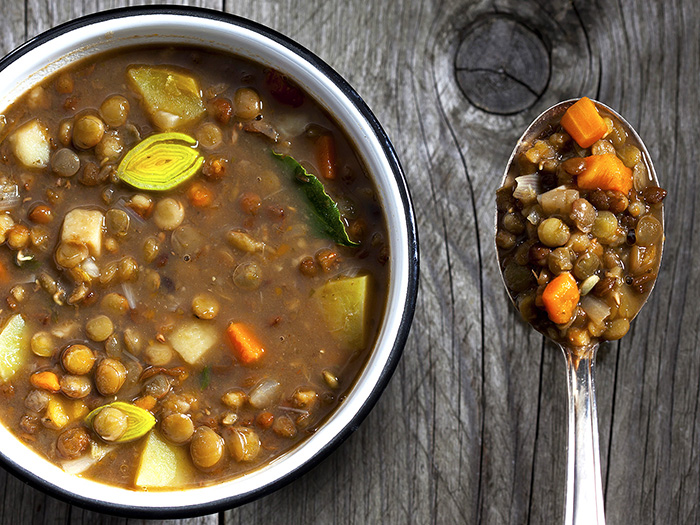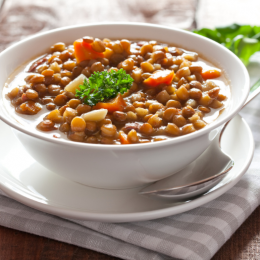Trying to Eat Less Meat? Add These 6 Foods to Your Grocery List
Get the protein, vitamins, and minerals your body needs with these options.

Eating less meat can be great for your health—or it can be a big misstep. Why? Because when it comes to any diet, it’s not what you don’t eat that determines your nutritional health. It’s what you do eat that matters most.
“It’s easy for people to fall into the trap of saying they are cutting out meat—and then filling up on potato chips and French fries,” says Caroline Susie, R.D., a Dallas-based dietitian. And that can have a radically different effect on your health than if you had subbed out meat for nutrient-packed whole foods.
Case in point: A 2017 Harvard School of Public Health study found people with a plant-based diet rich in whole grains and unprocessed foods reduce their risk of heart disease, but those who have a plant-based diet with refined grains and processed foods actually increase their risk.
So when you cut back on meat—or any particular food group—how you choose to fill the gap matters. Here are six great options to add to your grocery list.
1. Eggs
Eggs are the number-one bioavailable source of protein, which means your body can better absorb and use the protein from eggs than it can protein from any other food, meat included, Susie says. Apart from protein, eggs are also a great source of unsaturated fat and B vitamins, she adds.
Worried about your heart? It’s true that eggs, which are high in dietary cholesterol, were once considered off-limits. But the latest research shows dietary cholesterol doesn’t lead to high cholesterol in the blood. Of course, that doesn’t mean you should overdo it or drown your eggs in oil, butter, and cheese.
For most people, an egg or two a few times a week is a moderate amount. Boiling, poaching, and scrambling will help you retain the most nutrients without adding a lot of fat. And if you have heart disease, high cholesterol, or haven’t had your cholesterol checked in the past five years, ask your doctor for guidance.
2. Legumes
“A family of plants including beans, lentils, chickpeas, peas, and peanuts, legumes should be your new best friend,” Susie says. They’re among the best sources of plant-based protein your supermarket has to offer. And with generous helpings of fiber—eight grams per half-cup serving of lentils, for example—they’ll keep you feeling full longer.
Some studies have found legumes help people stay full an extra two to four hours after a meal, which may help control appetite. What’s more, the high iron levels in legumes may help fight off anemia, which is common among those with low-iron diets, like vegans and vegetarians.
Another reason to love legumes: They make great pantry staples, and they’re versatile. Use beans for chili, lentils for salad, or chickpeas for pita pockets.
3. Dairy
When you cut meat, you miss out on more than protein. Calcium along with vitamins D and B12 are also important nutrients to replace. Together, they help keep bones and muscles strong, and promote healthy energy levels. And dairy is a great source of all three.
“Milk substitutes just can’t compete with the nutrient profile of milk,” Susie says. Cow’s milk is rich in protein, magnesium, calcium, and vitamins D and B12.
One 2016 review in Food and Nutrition Research concluded that, despite public concerns over dairy being bad for you, milk and dairy consumption is linked to a reduced risk of type 2 diabetes, heart disease, stroke, and colorectal and breast cancer, not to mention improved bone mineral density.
If milk upsets your stomach, try small amounts of yogurt, buttermilk, or hard cheeses, which are lower in lactose. Still have digestive problems? Check in with your doctor for proper diagnosis and treatment.
4. Nuts
Your kitchen should always be stocked with nuts, says Sharon Palmer, R.D.N., author of Plant-Powered for Life. They are brimming with heart-healthy unsaturated fats, muscle-building protein, and cell-protecting antioxidants, she says.
Science agrees. A 2016 review published in BMC Medicine found that eating an ounce of nuts nearly every day was linked to reduced risk of heart disease and cancer, and lower death rates from diabetes and lung disease.
Subscribe to our newsletter
It's quick and easy. You could be one of the 13 million people who are eligible.
Already a member? Click to discover our 15,000+ participating locations.
Follow Us
Just remember to watch your portions. An ounce of nuts is only about a handful. For almonds, that’s about 164 calories and 14 grams of fat. To avoid mindless snacking, pour a portion into a cup or ramekin, and put the container away.
5. Whole Grains
Unlike refined grains, which have been stripped of their nutrient-filled bran and germ, whole grains still have all three parts of their kernel. Options like quinoa, oats, brown rice, barley, and freekeh are popular for their fiber content, but they’re also rich in plant-based protein, Susie says.
Another reason to add quinoa to your diet: Unlike most plant protein sources, quinoa contains all nine of the essential amino acids that your muscles need for growth and repair. Need recipe inspiration? Try this Basil Balsamic Salmon Quinoa Salad.
6. Soy
“Soy foods—tofu, tempeh, soy milk, edamame—are part of my diet every day,” Palmer says. Like quinoa, soy packs all nine of the essential amino acids. Soy foods are also rich in fiber, unsaturated fat, vitamins, and minerals like manganese, copper, and iron.
An easy way to start: Buy a bag of frozen edamame for a crunchy, nutritious snack. Feeling more ambitious? Try a tofu veggie stir-fry for a quick energizing meal.
It’s important to note that there’s a difference between these traditionally fermented soy products and highly processed soy products, such as many protein bars and fake meat. Read the ingredients label. If you see multiple words you don’t recognize or can’t pronounce, it’s best to walk away.
Check Your SilverSneakers Eligibility Instantly
SilverSneakers members can go to thousands of gyms and fitness locations across the nation, plus take exercise classes designed for seniors and led by supportive instructors. If you have a Medicare Plan, it may include SilverSneakers—at no additional cost. Check your eligibility instantly here.
Already a member? Get your SilverSneakers member ID and exclusive fitness content by logging in to or creating your online account here.





